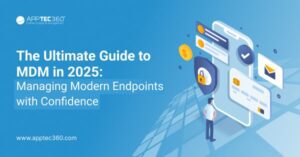If you are managing mobile devices in 2025, the EU Data Act is more than just another compliance requirement. The EU Data Act is not an MDM-specific law, but since it applies to connected devices, it has direct implications for MDM setups.
It represents a change in how data access, sharing, and control are regulated across the EU. Whether you are dealing with BYOD policies, legacy systems, or limited IT resources, this regulation sets clear expectations for how your MDM or UEM solution manages user data.
This guide explains how the EU Data Act impacts your MDM or UEM solution. It highlights what to focus on now and how to remain audit-ready without interrupting your operations.
Get a free trial of our MDM solution for up to 25 devices and see how easy managing your mobile ecosystem can be.
TL;DR
If you are an IT decision-maker or a security leader dealing with mobile device issues, especially in retail, healthcare, education, transport, and small to medium-sized enterprises, this blog is for you. It’s particularly useful for teams managing BYOD, legacy tech, and growing compliance demands.
Here’s what you’ll learn:
- What the EU Data Act means for your MDM strategy and why compliance is crucial
- How to prepare your MDM solution for EU compliance
- Key requirements like data portability, access control, and transparency
- A simple checklist to audit your MDM readiness and stay compliant
- Best practices to enable secure data sharing while empowering users
- Risks and penalties of non-compliance, and how to choose MDM vendors ready for evolving regulations
What Is the EU Data Act?
The EU Data Act is a regulatory framework aimed at making data from connected devices more accessible, portable, and reusable, across businesses, services, and end users. Unlike the GDPR, which focuses on personal data protection, the Data Act targets data generated by devices, which includes mobile endpoints managed via MDM (Mobile Device Management) systems.
If your organization relies on Apple MDM, Android MDM, or Windows MDM to control employee devices or apps, you’ll need to ensure that both users and approved third parties can access or transfer relevant data, securely and transparently.
Did You Know?
The EU Data Act is more than just a compliance measure; it is aimed at resolving the underutilization of data across multiple industries. The updated rules are set to unlock economic benefits and are forecasted to raise the EU’s GDP by €270 billion by 2028.
How Does the EU Data Act Affect Your MDM Strategy?
For IT teams, this regulation means your MDM or UEM (Unified Endpoint Management) solution must evolve beyond policy enforcement. The platform now needs to support data transparency, user access controls, and secure sharing. You must be able to show what data is collected from which devices, who has access to it, and how it’s being shared, particularly in BYOD and COPE setups where personal and corporate use overlap.
If you’re using legacy enrollment methods or struggling with fragmented endpoint systems, these new demands could stretch your IT team even further.
Key Requirements for MDM Compliance in 2025
Under the EU Data Act, your MDM setup needs to meet several technical and operational requirements:
- Data portability: Employees and authorized parties must be able to export their device and usage data
- Access control: Your solution must support role-based access and clear authorization layers for who sees what
- Transparency: Users must be notified of data collected and how it’s used, especially in hybrid-use cases
- Interoperability: Data should be available in a standardized format (e.g., CSV, JSON) for use across systems
Also Read
A Practical EU Data Act Compliance Checklist for MDM
To stay on the safe side of compliance, IT teams should review the following:
- Are you using ADE for Apple devices?
- Can users or admins export device and usage data in readable formats?
- Do you have logging and audit trails in place to track access events?
- Are BYOD users clearly informed about what’s monitored?
- Have you reviewed your MDM provider’s documentation for Data Act readiness?
If the answer to any of these is unclear, it’s time to audit your MDM environment.
Best Practices for Data Portability in MDM
Supporting data portability doesn’t have to be disruptive. Start by enabling structured data exports for both users and administrators, usage logs, app installs, and device configurations should be accessible in formats like CSV or JSON.
Use secure APIs to allow third-party tools access, where necessary, and make sure your app and profile management tools don’t block portability. If you’re managing devices via Apple VPP, Apple School Manager, or Android Enterprise, check if these configurations support seamless data sharing under controlled conditions.
What Happens If You Don’t Comply with the EU Act?
Non-compliance can lead to substantial fines, reputational damage, and potential restrictions on how your organization operates. Enforcement is expected to be taken seriously across the board.
But the impact goes beyond legal risk. Failing to align with the Data Act could undermine internal trust with employees, complicate B2B relationships, and slow down cross-system integrations. In sectors like healthcare or education, where data sensitivity is already high, the stakes are even greater.
Did You Know?
The EU Data Act (Regulation (EU) 2023/2854) was formally adopted in 2023 and will take effect from 12 September 2025. This transition period is designed to give organizations the time to align both technically and legally ensuring greater clarity and control around data access, sharing, and compliance.
Preparing Your MDM for the EU Data Act in 2025
Here’s what your IT team should do now:
- Conduct a system-wide MDM audit: Identify what data is being collected and where it’s stored.
- Switch to ADE: If your organization manages Apple devices, make sure you’re set up with Automated Device Enrollment (ADE).
- Enable data exports: Ensure both IT and users can easily export relevant device data.
- Review admin access policies: Limit data access to essential personnel using role-based controls.
- Update your BYOD policies: Make monitoring policies transparent and easy to access.
- Ask your MDM vendor the tough questions: Are they EU Data Act–ready? Can they show proof?
Choosing the Right MDM Software for EU Data Act Compliance
Not all MDM tools are keeping pace. When comparing solutions in 2025, look for:
- Native support for ADE, Android Enterprise, and ChromeOS MDM
- Transparent data access logs and export options
- Clear documentation about compliance practices
- Modern app and Kiosk Mode controls with audit features
In fast-moving sectors like retail or transport, rollout speed matters, choose a provider that supports easy deployment and low training overhead. At AppTec, we’ve built our MDM solution to meet the evolving needs of EU-regulated industries. From granular data control to simplified compliance management and full support for Apple’s ADE, our platform is designed to help you stay ahead of regulatory demands while keeping device management efficient and secure.
Also Read
Want a deeper dive into the real-world hurdles of managing mobile devices today?
Check out our blog on Top Mobile Device Management (MDM) Challenges in 2025 and How to Solve Them, packed with practical tips to help you stay ahead.
How Does the EU Data Act Reshape Enterprise Mobility?
For IT and security leaders, the EU Data Act turns compliance from a routine task into a strategic priority. Managing enterprise mobility today means more than enforcing device usage policies. It requires empowering users with clear access to their device and app data, enabling secure and seamless data sharing across internal systems and trusted third parties, and maintaining full visibility across diverse device types and operating systems.
This shift requires an MDM strategy that strikes a balance between user productivity and regulatory compliance, particularly in complex environments such as retail, healthcare, and education.
Centralized control through UEM software becomes essential, especially as teams grow more distributed. Mobility leaders are now tasked with balancing productivity and traceability, and the right MDM setup is key to achieving that balance while keeping compliance efficient and scalable.
Wrap-Up
As 2025 brings the EU Data Act into force, organizations can no longer afford to treat MDM and compliance as separate priorities. Whether you are managing BYOD setups, legacy devices, or a mix of operating systems, your Mobile Device Management solution must support transparent data handling, secure access, and user empowerment.
- Choosing the best MDM software is not just about features; it is about future-proofing your enterprise mobility strategy.
- Look for MDM solutions that support ADE, offer strong App Management, and align with both your security needs and compliance goals.
- If you are evaluating an MDM provider list or conducting an MDM software comparison, prioritize vendors that clearly document their EU Data Act readiness. Do not wait until regulators come knocking.
- Take proactive steps now to ensure your UEM or MDM solution supports both your workforce and your legal responsibilities.
Need an MDM solution that’s ready for the EU Data Act? Explore our enterprise-grade MDM services or get in touch to see how AppTec can support your compliance journey with confidence. Contact our team and see how we can support your journey.
FAQ
1. Who does the EU Data Act apply to, and does it include smartphones and connected devices?
The EU Data Act applies broadly to connected products and related services, such as smartphones, IoT devices, and cloud services managing device data. If your devices collect or process data and your operations reach EU users.
2. Do the EU Data Act’s data sharing obligations conflict with GDPR?
No, the EU Data Act complements, rather than replaces, GDPR. While GDPR focuses on personal data protection, the Data Act governs access and use of data generated by devices, including both personal and non-personal data.




